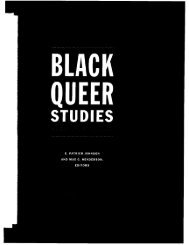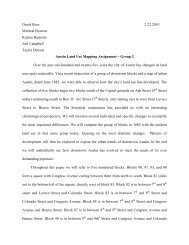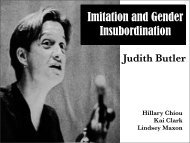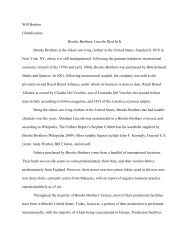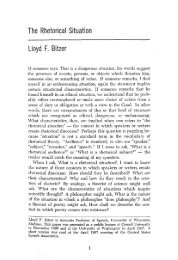Coherence, Cohesion, and Writing Quality Stephen P. Witte; Lester ...
Coherence, Cohesion, and Writing Quality Stephen P. Witte; Lester ...
Coherence, Cohesion, and Writing Quality Stephen P. Witte; Lester ...
You also want an ePaper? Increase the reach of your titles
YUMPU automatically turns print PDFs into web optimized ePapers that Google loves.
190 College Composition <strong>and</strong> Communicationwhich are linked together by explicit cohesive ties. <strong>Cohesion</strong>, therefore, definesa text as text. A cohesive tie "is a semantic relation between an element ina text <strong>and</strong> some other element that is crucial to the interpretation of it" (p.8). The two semantically connected elements can lie within the text or oneelement can lie outside the text. Hallida~ <strong>and</strong> Hasan call within-text cohesiveties endophoric <strong>and</strong> references to items outside the text exophoric. An exampleof an exophoric reference is the editorial "we" in a newspaper. Such referencesare exophoric because no antecedent is recoverable within the text.Exophoric references often help link a text to its situational context; but, asfar as Halliday <strong>and</strong> Hasan are concerned, exophoric references do not contributeto the cohesion of a text. For Halliday <strong>and</strong> Hasan, cohesion dependsupon lexical <strong>and</strong> grammatical relationships that allow sentence sequences tobe understood as connected discourse rather than as autonomous sentences.Even though within-sentence cohesive ties do occur, the cohesive ties across"sentence boundaries" are those which allow sequences of sentences to beunderstood as a text.Halliday <strong>and</strong> Hasan's concept of textuality, defined with reference to relationshipsthat obtain across "sentence boundaries," suggests a number of possibilitiesfor extending composition research beyond its frequent moorings insentence-level operations <strong>and</strong> features. The major purpose of the presentstudy is to apply two taxonomies of cohesive ties developed by Halliday <strong>and</strong>Hasan to an analysis of essays of college freshmen rated high <strong>and</strong> low inquality. Because <strong>Cohesion</strong> in English is a pioneering effort to describe relationshipsbetween <strong>and</strong> among sentences in text, we anticipate that cohesionwill be studied in future research addressing the linguistic features of writtentexts. We are particularly interested in identifying what purposes Halliday<strong>and</strong> Hasan's taxonomies can serve in composition research <strong>and</strong> what purposesthey cannot serve.Halliday <strong>and</strong> Hasan's System for Analyzing <strong>and</strong> Classifying CohesiveTies<strong>Cohesion</strong> in English specifies five major classes of cohesive ties, nineteensubclasses, <strong>and</strong> numerous sub-subclasses. In the analysis of cohesion whichfollows, we will be concerned with only the five major classes-reference, substitution,ellipsis, conjunction, <strong>and</strong> lexical reiteration <strong>and</strong> collocation-<strong>and</strong> theirrespective subclasses. Two of the major classes-substitution <strong>and</strong> ellipsis-aremore frequent in conversation than in written discourse. Substitution replacesone element with another which is not a personal pronoun, <strong>and</strong> ellipsis involvesa deletion of a word, phrase, or clause. The effect of both substitution<strong>and</strong> ellipsis is to extend the textual or semantic domain of one sentence to asubsequent sentence. The word one in sentence (2) illustrates cohesion basedon substitution <strong>and</strong> the word do in sentence (4) illustrates cohesion based onellipsis.




